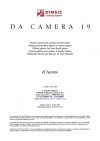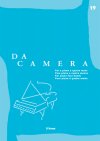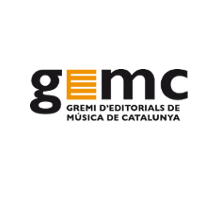Peça núm. 7 per a piano a quatre mans

Inside Pages
Author/Composer
Field
Collection
Da Camera (separate PDF pieces) Nr. 1907
Language
Spanish, Catalan, Music, English, French
Format
Instruments
Four Hands PianoTechnical Specifications
Measurements
21 x 29,7 cm, vertical
Number of Pages
3
ISMN
979-0-69232-025-8
Editor
DINSIC Publicacions Musicals
Related Publications
Da Camera 19
12.22 €
Da Camera 19
Array
(
[Relacionat] => Array
(
[id] => 262
[publicacion_id] => 11791
[publicacion_id1] => 2249
[type] => relacionada
)
[pub] => Array
(
[Publicacion] => Array
(
[id] => 2249
[titol] => Da Camera 19
[url] => score-dc19-da_camera_19
[codi] => DC19
[intro] =>
[continguts_generals] => When presenting this little piece entitled Da Camera 19, fifteen pieces for four-hand piano, I would like to remind:
1. That the four-hand interpretation imposes the performers to commit to a strict rhythm .
2. That the four-hand interpretation on a piano keyboard is able to produce melodic, harmonic and rhythmic effects that are extremely rich, without a great difficulty of execution.
3. That establishing a musical dialogue with someone else -and specially when those who speak are young- is always more interesting, more fun and more enriching than speaking alone.
After reminding all this, I would only like to add that the themes that motivate the musical dialogue of this little work evoke the popular inspiration, but they are expressed through a very proper and present language; to me it is like seeing the eyes of always on today's face.
D´Auves
[estructuracio] =>
[material_descarga] => 0
[titol_descarga] =>
[info_descarga] =>
[num_pags] => 28
[ismn] => M-69210-038-6
[diposit_legal] =>
[codi_barres] =>
[isbn] =>
[preu] => 12.50
[exhaurit] => 0
[oferta] => 0
[en_preparacio] => 0
[recomanat] => 0
[novetat] => 0
[format] => Partitura
[ctecnica] =>
[ilustracion] =>
[num_pagines_interiors] => 0
[n_pag_annex] =>
[numero_particelas] =>
[numero_pagines_particelas] =>
[durada] =>
[visible_instrumentacio] => 1
[visible_formacions] => 1
[pdf_car_estructuracio] => 0
[pes] => 0,140
[published] => 1
[created] => 2006-07-28 12:59:32
[modified] => 2025-07-10 15:44:07
[ordenacion] => 2006-07-28 12:59:32
[puntuacio] => 0.00
[visto] => 4184
[rating] => 0.0
[votes] => 0
[parent] =>
[has_child] => 0
[locale] => en_gb
)
[Audit] => Array
(
)
[Category] => Array
(
[0] => Array
(
[id] => 88
[url] => basico
[name] => Básico
[parent_id] => 78
[descripcio] =>
La clasificación del nivel de una partitura normalmente viene determinado por el grado de dificultad técnica del instrumento o voz. En los casos de obras para formaciones instrumentales diversas, orquestales, vocales, etc. el nivel se determina atendiendo a la complejidad general de la obra, no a la de sus instrumentos en particular. Es muy importante conocer este criterio porque las obras de conjunto aparecen también en los listados específicos de cada uno de sus instrumentos o voces que participan en él, pero el nivel que se indica es el de la formación instrumental-vocal.
[order] => 2
[lft] => 2
[rght] => 3
[published] => 1
[PublicacionsCategory] => Array
(
[id] => 276
[publicacion_id] => 2249
[category_id] => 88
)
)
)
[Idioma] => Array
(
[0] => Array
(
[id] => 116
[nom] => Catalan
[published] => 1
[url] => catalan
[PublicacionsIdioma] => Array
(
[id] => 434
[publicacion_id] => 2249
[idioma_id] => 116
)
)
[1] => Array
(
[id] => 103
[nom] => Castellà
[published] => 1
[url] => castella
[PublicacionsIdioma] => Array
(
[id] => 435
[publicacion_id] => 2249
[idioma_id] => 103
)
)
[2] => Array
(
[id] => 1724
[nom] => English
[published] => 1
[url] => english
[PublicacionsIdioma] => Array
(
[id] => 436
[publicacion_id] => 2249
[idioma_id] => 1724
)
)
[3] => Array
(
[id] => 1879
[nom] => Francés
[published] => 1
[url] => frances
[PublicacionsIdioma] => Array
(
[id] => 1865
[publicacion_id] => 2249
[idioma_id] => 1879
)
)
[4] => Array
(
[id] => 142
[nom] => Music
[published] => 1
[url] => international
[PublicacionsIdioma] => Array
(
[id] => 9105
[publicacion_id] => 2249
[idioma_id] => 142
)
)
)
[Rsspost] => Array
(
)
[Archivesrelation] => Array
(
[0] => Array
(
[Archivesrelation] => Array
(
[id] => 1926
[model] => Publicacion
[foreign_id] => 2249
[order] => 0
[file_id] => 2530
[archivestypes_id] => 2
)
)
[1] => Array
(
[Archivesrelation] => Array
(
[id] => 1927
[model] => Publicacion
[foreign_id] => 2249
[order] => 0
[file_id] => 2531
[archivestypes_id] => 3
)
)
)
[PublicacionsIdioma] => Array
(
[Idioma] => Array
(
[id] => 116
[nom] => Catalan
[published] => 1
[url] => catalan
[locale] => en_gb
)
)
)
[path] => scores-elementary
)
13.00 €











